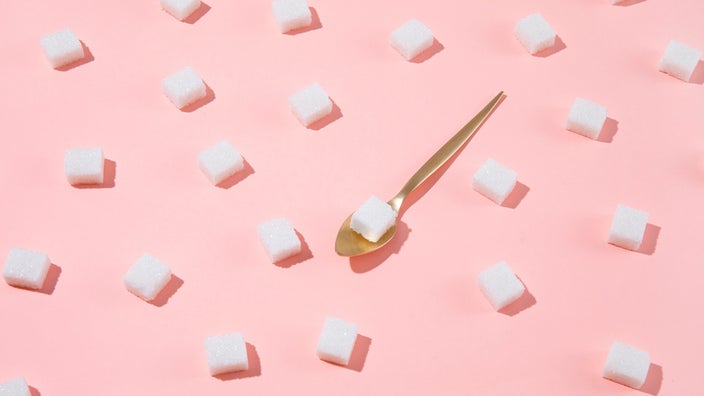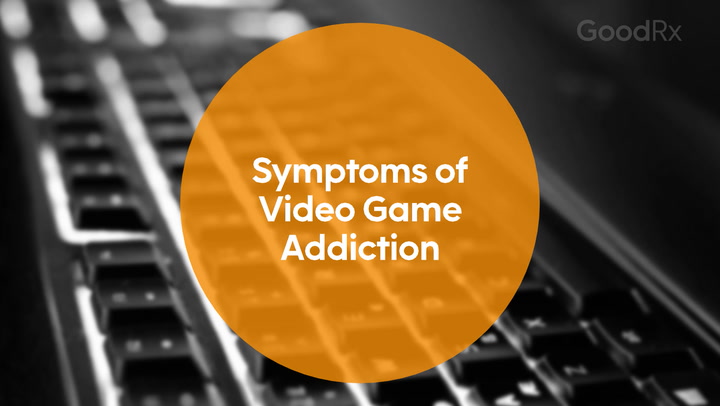
Are You Addicted to Sugar? How to Break Sugar Addiction
Key takeaways:
Scientists haven’t determined for sure whether sugar is addictive.
There are addictive behaviors, such as binges and cravings, that you may show when you eat sugar.
Consuming too much sugar is linked to many health problems, but there are strategies for being more mindful of your sugar intake.
Table of contents

Maybe you’ve had the experience of eating a cupcake and having a hard time stopping at just one. Or maybe you planned to eat just one piece of chocolate but ended up eating half the box instead. Does this mean you’re addicted to sugar? The answer isn’t quite as straightforward as you might think.
For the purposes of this article, when we use the word sugar, we mean added sugar. These are the sugars that are added to processed foods like candy, soda, and baked goods. This doesn’t include the sugar that naturally exists in foods like milk and fruit.
Read on to learn how sugar affects the body compared to addictive substances like drugs and alcohol. We’ll also share strategies for cutting back on your sugar intake.
Save over 40% on Qsymia with GoodRx
Discover the once daily Qsymia for weight management. Qsymia is for adults and children 12-17 in combination with a healthy diet and regular exercise.

Is sugar addictive?
It’s unclear. Scientists don’t know for sure whether sugar — or food in general — is addictive.
There hasn’t been much research on sugar addiction in humans. Most of the research on sugar addiction has focused on animals. And these studies have found similarities between how laboratory rats respond to sugar and how they respond to drugs.
But researchers continue to debate whether sugar is addictive for humans. Some think sugar is a behavioral addiction, like gambling. Others think it could be a substance addiction. We need more research to know for sure.
What researchers do agree on is that people show certain addictive behaviors when they consume sugar.
Signs of a sugar addiction
To receive a diagnosis of a substance use disorder, you need to meet at least two (of 11) criteria in the Diagnostic and Statistical Manual of Mental Disorders (DSM-5) within a 12-month period.
In studies, scientists found that laboratory rats met five of these criteria for sugar addiction. The five criteria are:
Impaired control (binging)
Cravings
Continued use despite risk
Withdrawal (experiencing physical symptoms that are relieved with the use of the substance)
Tolerance (needing more of the substance to get the effect you want)
Natural sugar vs. refined sugar: Foods like fruit that contain natural sugars also provide nutrients that benefit your overall health. Refined sugar has no health benefits.
How to reduce sugar in your diet: Small, gradual diet adjustments make it easier to cut back on sugar. And instead of doing a strict “detox,” consider a long-term, sustainable approach.
The best and worst sweeteners: Whether or not you have diabetes, it’s important to know which sweeteners raise your blood sugar quickly and which don’t.
How to spot hidden sugars on food labels: A package may not list sugar outright, but it might still be used. Here are the hidden sugars to know about.
The question is whether these results might also apply to humans.
How to break a sugar addiction
Fortunately, there are things that you can do to limit how much sugar you consume.
Try dietary strategies to reduce sugar intake
Tips for limiting sugar intake include:
Replacing breakfast cereals with oatmeal or eggs
Using fresh fruit to sweeten yogurt, pancakes, and oatmeal
Snacking on unsweetened dried fruit instead of candy
Substituting small amounts of honey or maple syrup for refined sugar
Eating snacks that contain protein and/or fiber, which are filling
Avoiding sweetened drinks like soda, sweetened iced tea, and sports drinks — and replacing them with sparkling water or flat water with fresh fruit chunks and herbs
Keeping sugary foods like candy and cookies outside the home to make them less accessible
Making sure you grocery shop with a list in hand, and when you’re not hungry
Reading ingredient labels on food items before buying them
Read more like this
Explore these related articles, suggested for readers like you.
Limiting your sugar exposure will make it easier to reduce your sugar cravings and binges.
Get expert help from dietary counseling
Of course, you can still enjoy your favorite sweets in moderation. You don’t need to cut out all sugar from your diet. The key is to maintain a balanced diet overall, and consume the right number of calories for your activity level. Consulting with a dietitian can help you create an eating plan that works for your needs.
Address emotional triggers
For many people, a relationship with sugary foods may be tied to emotions. It’s not uncommon to self-soothe by eating comforting foods. It’s a normal human response, given that we learn as babies that food is a source of comfort, and can relax our nervous system. But there are strategies that can help you reduce emotional eating, such as:
Learning to understand (and feel) the difference between emotional hunger and physical hunger
Recognizing your triggers
Finding ways to cope with intense emotions, such as exercise or mindful eating
Therapy
Why am I addicted to sugar?
Eating sugar can activate pleasure centers in your brain. This can trigger cravings and a feeling of wanting more. Over time, you may need to consume more sugar to get the same level of pleasure. That’s because your brain’s reward pathway develops a tolerance to sugar. This tolerance — along with cravings — are often the hallmarks of addiction.
Scientists think that whether you get addicted to sugar may depend on two factors: the type of food and your individual characteristics. For example, one study found that eating cookies led to an addictive response for some individuals. For others, bananas caused that same response. In other words, the foods that cause someone to feel a lack of control may vary from person to person.
What are the health risks of eating sugar?
Added sugars are empty calories. This means that foods with added sugar contain a high amount of calories but very little nutritional value. As a result, eating large amounts of added sugars puts you at risk of:
Weight gain
Diabetes
Obesity
Cardiovascular disease
Higher triglycerides and bad cholesterol
Lower good cholesterol
How much sugar is OK to have per day?
Experts recommend that no more than 10% of your daily calories come from added sugar. So a person who eats about 2,000 calories a day should get 200 or fewer calories (around 50 g) from sugar.
The American Heart Association has slightly stricter limits. They recommend:
Less than 36 g of sugar (9 tsp) per day for men
Less than 25 g of sugar (6 tsp) per day for women
Is sugar as addictive as drugs and alcohol?
There are some similarities between the way sugar works in the body and the way drugs and alcohol work in the brain.
Dopamine
Sugar releases dopamine in your body, which is why most people enjoy eating sweets. Dopamine is the “feel good” chemical that helps you experience pleasure. In laboratory studies with rats, researchers found that sugar releases dopamine in a way that’s similar to the way drugs release dopamine. And researchers found that sugar activates the reward pathways in the rats’ brains in the same way that cocaine does.
Withdrawal
It’s common to experience withdrawal after stopping or reducing intake of an addictive substance like drugs or alcohol. Withdrawal refers to the physical and mental symptoms you might feel as your body gets used to not having that substance.
Some people have reported experiencing withdrawal symptoms from sugar. But researchers have yet to find study results that back up this claim. It might also be that the “withdrawal” symptoms you experience by abruptly quitting sugar could be your body adjusting to your change in diet, even if it’s a positive change.
Scientists are still working on an exact definition of sugar withdrawal.
Frequently asked questions
There’s no set amount of time that it takes to break a sugar “addiction,” given that scientists haven’t determined for sure whether sugar is addictive.
Remember, your body needs sugar on a daily basis to survive. So the goal should be to eat fewer sugary foods, not to eliminate sugar entirely. The experience — and timeline — of cutting back on sugar will vary for each person.
When reducing your sugar intake, it’s best to make small, gradual adjustments to your diet. Try to make changes that you can stick with over time.
There are plenty of foods that are naturally sweet. Try:
Fresh fruit, like berries, melon, mango, and grapes
Dried fruit (choose types without added sugar)
Nut butter
Dark chocolate
Greek yogurt with a drizzle of honey
Baked fruit with cinnamon or other spices
The bottom line
We don’t yet know for sure whether sugar is addictive. Animal studies suggest that it may be. But we do know that there are addictive behaviors, such as binges and cravings, that you may show when you eat sugar. There are also many health risks that come from eating too much sugar. Fortunately, there are small changes you can make to limit your intake of added sugar. Try swapping out breakfast cereals for eggs, using fresh fruit to sweeten foods like yogurt and oatmeal, and eating foods that contain protein and/or fiber, which are filling.
Why trust our experts?



References
Ahmed, S. H., et al. (2013). Sugar addiction: Pushing the drug-sugar analogy to the limit. Current Opinion in Clinical Nutrition and Metabolic Care.
Avena, N. M., et al. (2009). Evidence for sugar addiction: Behavioral and neurochemical effects of intermittent, excessive sugar intake. Neuroscience and Biobehavioral Reviews.
American Heart Association. (2024). How much sugar is too much?
Bailey, R. L., et al. (2018). Sources of added sugars in Young children, adolescents, and adults with low and high intakes of added sugars. Nutrients.
Cooper, S., et al. (2017). Reward circuitry in addiction. Neurotherapeutics.
DiNicolantonio, J. J., et al. (2018). Sugar addiction: Is it real? A narrative review. British Journal of Sports Medicine.
Door County, WI Government. (n.d.). Criteria for substance use disorders DSM-V.
Frayn, M., et al. (2018). Emotional eating and weight regulation: A qualitative study of compensatory behaviors and concerns. Journal of Eating Disorders.
Greenberg, D., et al. (2021). Sugars and sweet taste: Addictive or rewarding? International Journal of Environmental Research and Public Health.
Hoebel, B. G., et al. (2015). A behavioral and circuit model based on sugar addiction in rats. Journal of Addiction Medicine.
Miller, J. (2024). Sugar withdrawal symptoms. AddictionHelp.com.
News in Health. (2014). Sweet stuff: How sugars and sweeteners affect your health. National Institutes of Health
Office of Disease Prevention and Health Promotion. (2016). Cut down on added sugars.
Rada, P., et al. (2005). Daily bingeing on sugar repeatedly releases dopamine in the accumbens shell. Neuroscience.
Westwater, M. L., et al. (2016). Sugar addiction: The state of the science. European Journal of Nutrition.
Zeevi, D., et al. (2015). Personalized nutrition by prediction of glycemic responses. Cell.
If you or someone you know struggles with addiction, help is available. Call SAMHSA’s National Helpline at 1-800-662-4357 to learn about resources in your area.





















